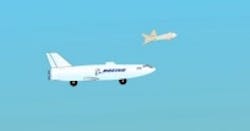[Page 2] UAV roundup 9/25: The latest in unmanned aerial vehicle news
Editor's note: This article is continued frompage one.
In its comments, the association said, "The limitation on nighttime operations should be removed to align better with risk, as has been done in countries such as New Zealand. Many SUAS have lights that make them highly visible at night and operations in controlled settings make SUAS essential assets at night. For example, SUAS have been used in Australia to help fight wildfires at night when manned operations cannot continue."
Read more of the AUVSI’s commentshere.
Boeing patent UAV that turns into a submarine
Boeing has received approval on a patent application for a UAV that transforms into a submarine.
The patent, which was filed by Nathan Hiller, is for a "rapid deployment air and water vehicle." According to Boeing the craft could be carried into a deployment area by a host aircraft and the remotely-piloted drone would then detach from the carrier aircraft and fly on its own. From there, the drone would be able to dive under the surface of the water, where a set of water-borne propellers and control surfaces would appear in place of the detached wings and airborne propellers.
Boeing describes the project in the patent as follows:
A vehicle adaptable for both flight and water travel comprising: a body configured to fly through air and to move through water; a wing or a stabilizer attached to the body while in flight; a first set of propelling blades attached to the body while in flight, the first set of propelling blades configured to propel the body through air while the body is in flight; a second set of propelling blades, coaxial with the first set of propelling blades, the second set of propelling blades attached to the body when the body is in flight and when the body is in the water, the second set of propelling blades configured to propel the body through water while the body is in the water; and at least one attachment member attaching the first set of propelling blades to the body while the body is in flight, wherein the at least one attachment member detaches the first set of propelling blades from the body when the body is in the water.
Learn more about the Boeing dronehere.
Sony prototype drone does vertical takeoff
Sony is developing a drone with a Tokyo robotics firm under a collaboration company called Aerosense. The UAV, which launches vertically, can carry up to 22 pounds, and fly continuously for two hours at a speed of 106 mph. Sony expects that business customers will be able to use it for "measuring, surveying, observing and inspecting" as soon as next year.
View the drone in action onEngadget.
Got something we should know about?Let us know.
Share your vision-related news by contactingJames Carroll, Senior Web Editor, Vision Systems Design
To receive news like this in your inbox,click here.
Page 1 | Page 2
About the Author

James Carroll
Former VSD Editor James Carroll joined the team 2013. Carroll covered machine vision and imaging from numerous angles, including application stories, industry news, market updates, and new products. In addition to writing and editing articles, Carroll managed the Innovators Awards program and webcasts.

